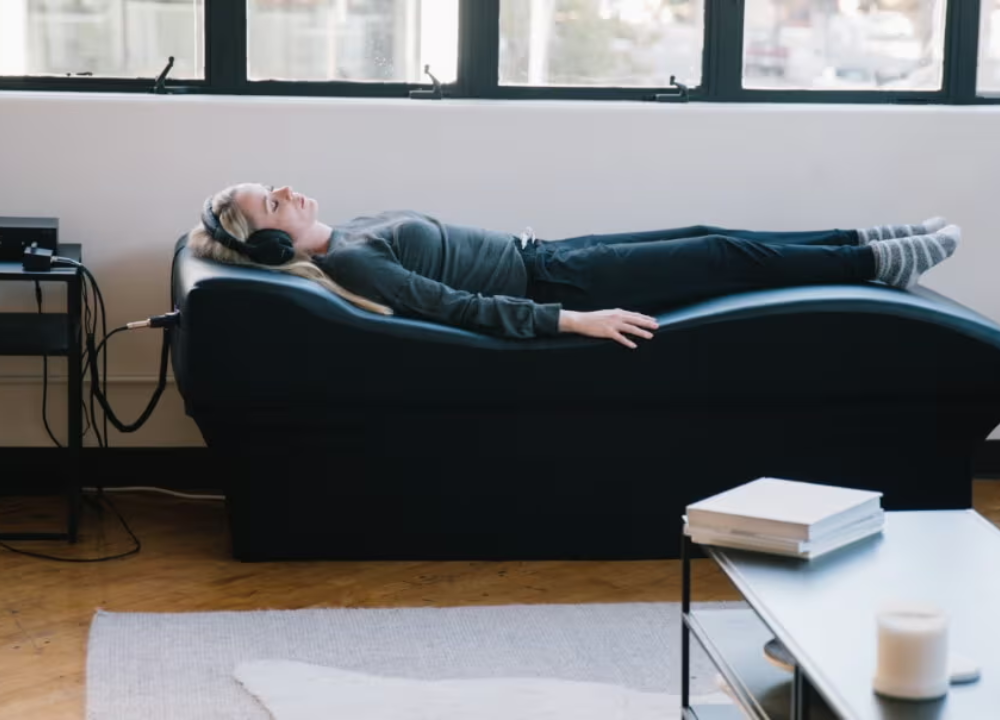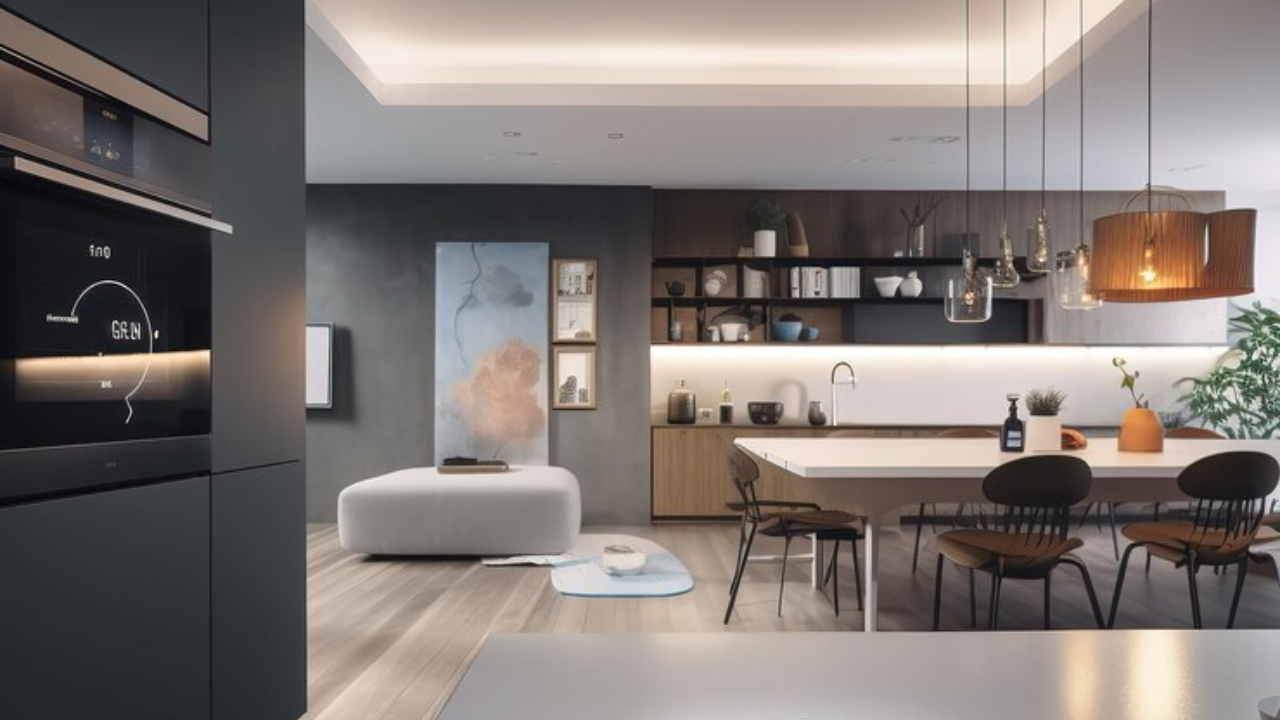- What Is Sound Bed Therapy?
- Design and Technical Specifications of Sound Bed Therapy Devices
- How Does Sound Bed Therapy Work?
- Benefits of Vibroacoustic Sound Bed Therapy
- Scientific Research Behind Sound Bed Therapy
- Immersive Content and Programs in Sound Bed Therapy
- Sound Bed Therapy Sessions: What to Expect
- Sound Bed Therapy Safety Guidelines and Contraindications
- Finding Sound Bed Therapy Centers, Costs, and Booking Options
- Sound Bed Therapy Purchase and Usage Guide
- Frequently Asked Questions
- Conclusion
Sound bed therapy is a paradigm-shifting solution to well-being and blends the traditional science of sound healing with the current scientific research of vibroacoustic therapy. This new kind of therapy will give you a chance to almost literally touch the music and therapeutic frequencies with your whole body, which means that you will be able to experience it like you have never experienced relaxation techniques before.
Sound bed therapy contrasts with the traditional sound baths, whereby you only hear healing sounds, but in the sound bed therapy, therapeutic vibrations are provided to you directly through your body through special beds that are fitted with transducers. These are gadgets that translate sound waves into smooth mechanical movements that reverberate in your body tissues, nervous system, and cellular system. The outcome is a strong change from stress-related fight-or-flight to a healing rest-and-digest state of deep relaxation.
What Is Sound Bed Therapy?
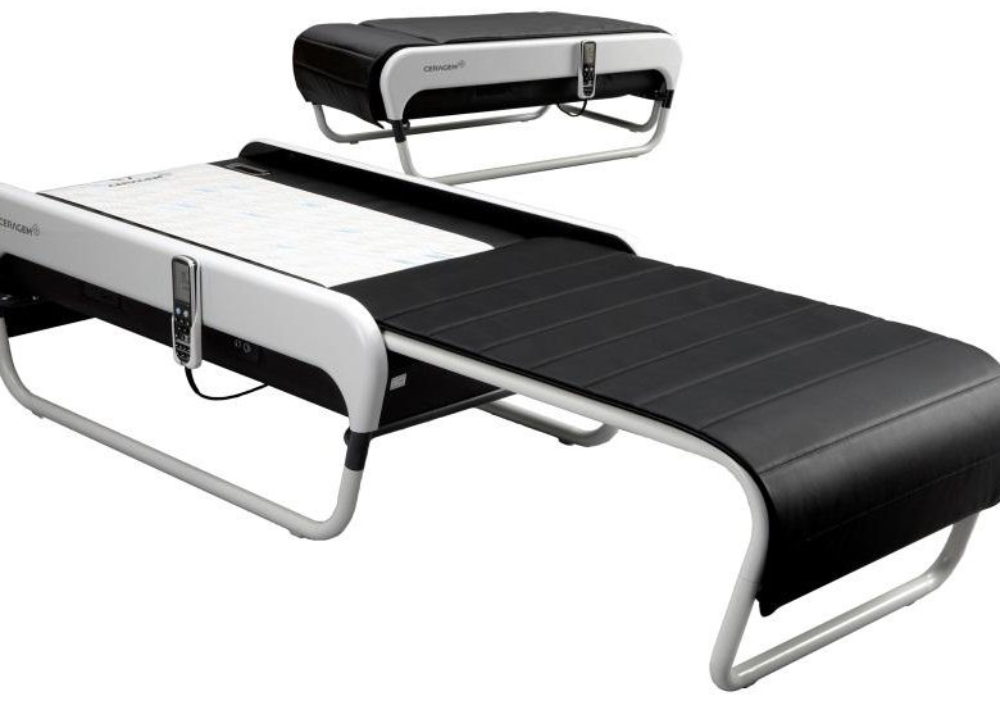
Sound bed therapy (or vibroacoustic therapy or vibrational wave therapy) is an alternative wellness treatment that involves special sound frequencies along with low-amplitude vibrations to facilitate healing and relaxation. It is a kind of therapy that requires a patient to lie on a specially designed bed or mat that produces a therapeutic vibration along with coordinated music or tones through speakers or even using headphones.
Sound bed therapy technology converts sound frequencies that are received as audible to mechanical vibrations that travel throughout your body. These vibrations are normally between 30-120 HZ, which is more of a feeling than a sound. When you lie on a sound bed, these low vibrations are able to enter you through your skin and muscles through the declared mechanoreceptors, which is what enables a person to feel touch or even feel the bass in a concert.
Modern sound bed therapy is grounded in ancient healing practices that have been known to rely on the healing properties of sound for a long time now. The current study has its roots in the Egyptian healing songs as well as in Tibetan singing bowls, in which all cultures in the world have used music and vibrations together with rhythms to promote inner calmness and well-being. Sound bed technology today is merely that: a more accurate, controlled, and more immersive method of experiencing these age-old principles of healing.
Design and Technical Specifications of Sound Bed Therapy Devices
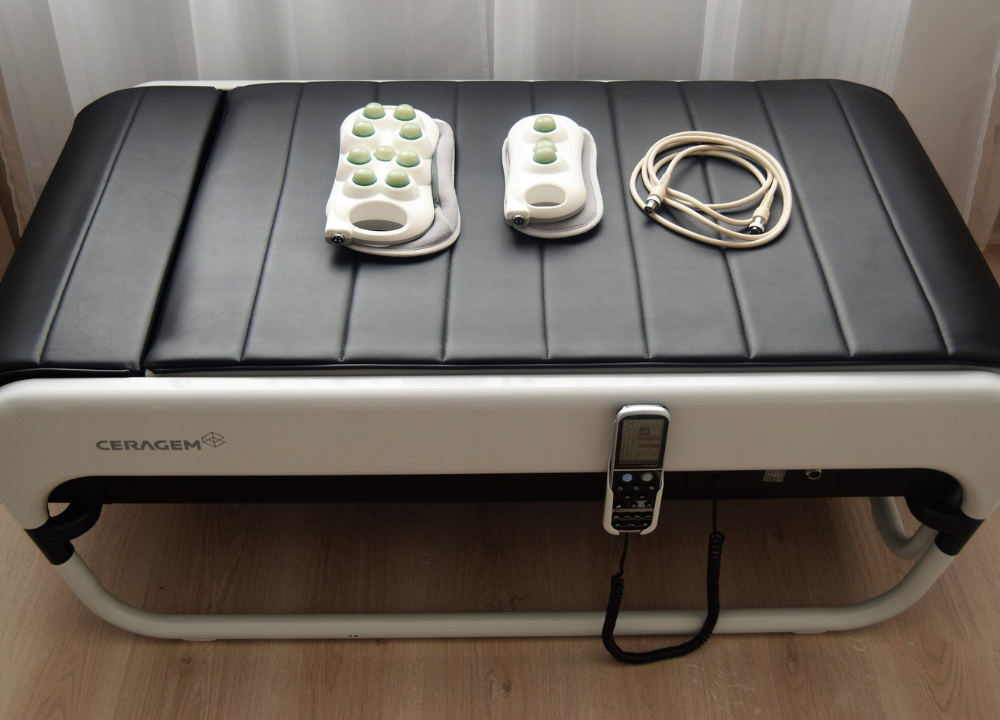
Sound bed machines are high-tech engineering that is designed to provide you with therapeutic vibrations while being comfortable and convenient. Recognition of their design can find value in the way these new devices become part of the contemporary wellness process almost naturally.
Physical Construction and Materials
New sound beds are sophisticatedly minimalistic and go well in any environment, whether at the workplace wellness hub or even at home. The standard construction will consist of a lightweight yet solid bottom, which can be made of a layer of glass-reinforced plastic, as this will be durable. The sleeping surface is made of high-density foam mattresses, and the top cover is breathable.
Quilted fabrics—this is mostly having mixed material, i.e., natural materials, usually wool, polyester, nylon, and elastane, to provide the best comfort and support.
Portability and Space Efficiency
Most of the good bed designs are portable and functional. Other devices are rollable or foldable, and they go from the full length of the treatment surface (approximately 71 x 24 x 12 inches) to a smaller cube (approximately 24 x 24 x 24 inches) size when they are not in use. The flexibility in this therapy is that sound bed therapy can be used in the home without the need for a designated area.
Vibration Technology and Zones
The main technology is multi-vibration, which involves multi-zones of vibration, generally around five to seven channels, placed at strategic areas to provide sensations on areas from head to toe. Transducer ( kind of speaker, good qualitytransmitst the sound frequencies to vibrations that the body can feel. Different zones may be configured to a particular interest in the body zones or synchronous all-body vibrations that immerse the user in therapeutic vibrations.
Connectivity and Control Systems
Contemporary sound beds also provide wireless connectivity with Internet-based services via Wi-Fi (typically in the 2.4 GHz bands) and complementary applications where users can choose programs, set vibration levels, and customize sessions. Audio connections have standard 3.5mm headphone connections to audio sources with no need to carry adapters.
How Does Sound Bed Therapy Work?
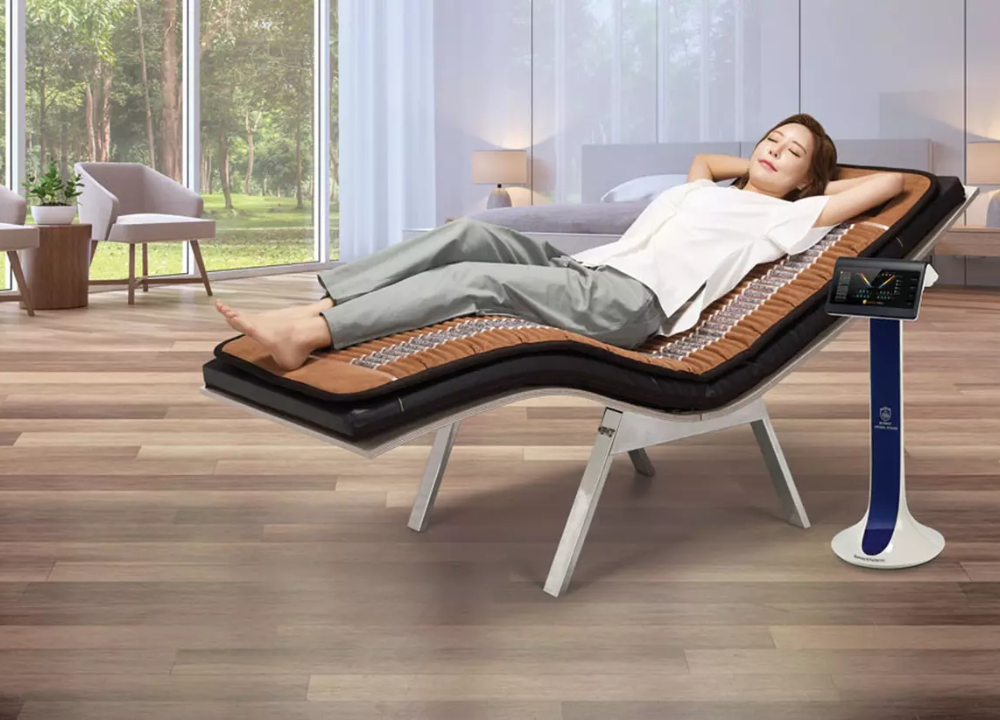
The principle of sound bed therapy operates on a highly interesting interaction of sound, vibration, and the natural healing processes of your body. When you are lying in a sound bed, special transducers are used that make low-frequency vibrations run through your body with a simultaneous accompaniment of specially coordinated music or medical sounds. This brings out a three-dimensional, physiological experience of hearing and feeling the same healing frequencies.
The therapeutic vibrations are usually within a spectrum of 30-120 Hz, which is the type of frequency that goes deep into tissues and is in sync with the rhythms of your body. Your body sends these vibrations to different parts through a process using your mechanoreceptors, a familiar type of sensory cell that is used in detecting touch and pressure. The effect is a massage within your body: the delicate waves pass over your body in the rhythm of the sounds, healing it.
The combination of sound and vibration stimulates several senses at the same time, becoming much more immersive than the classical forms of relaxation. After a few minutes of using a session, the slowdown of breathing is observed in most users, the tension of the muscles disappears, and they can fall into a meditative state or sleep lightly because stress and anxiety gradually recede.
Benefits of Vibroacoustic Sound Bed Therapy
Sound bed therapy is more than just a short-lived relaxation, and the multiple benefits of the treatment spill over to place long-term advantages on a person psychologically as well as physically. A lot of favorable results after frequent vibroacoustic sessions have been documented by studies and clinical observation.
Stress and Anxiety Reduction
Recently, sound bed therapy has been proven to have a fast effect on encouraging deep states of relaxation, which serves in reducing cortisol levels in the body, which is your primary stress hormone. These low-level vibrations activate your parasympathetic nervous system, and this effectively brings your body out of the state of perpetual stress. Consumers keep stating that they become more grounded, less nervous, and more relaxed after sessions.
Enhanced Sleep Quality
The sound bed therapy results in deep relaxation, which is usually associated with better sleeping patterns. Numerous users have reported calmer sleep on the night after sessions, as the therapy helps calm the overactive mind and relax the physical tension that otherwise would disturb the natural sleeping pattern.
Pain Relief and Muscle Tension Reduction
The vibrations in the low frequency are a sort of micro-massage system, which serves to loosen pressurized muscle knots and relax chronic pains. This, in its turn, renders the application of sound therapy in beds rather helpful to sufferers of fibromyalgia, chronic aches or pains, muscle aches, or headaches. The vibrations provide full-body circulation as well as the secretion of endorphins, which are natural pain relievers, into the body.
Mood Enhancement and Emotional Balance
Sound bed therapy can be effective in improving mood by increasing the release of such good neurotransmitters as serotonin and endorphins and lowering stressful neurotransmitters. There are several testimonials by users who feel happier, emotionally stable, and more prepared to cope with everyday challenges after frequent sessions.
Cardiovascular Benefits
Because the nervous system enters a state of relaxation during a sound bath therapy session, your heart rate slows; it is also possible that your blood pressure will go down. The common practice may improve the cardiovascular system and stability under stress in the long run.
Improved Circulation and Recovery
The therapeutic vibrations expand the blood vessels and activate the blood circulation in the body in favor of the self-cleaning processes and post-exercise recovery. Such enhanced blood flow helps in the relaxed and warm feeling most people acquire at the end of sessions.
Scientific Research Behind Sound Bed Therapy
Though sound bed therapy is a therapy that is comparatively recent in the medical spectrum of things, a lot of what has been articulated has some supporting data from upcoming research. In a considerable pilot published in Frontiers in Psychology in 2022, vibroacoustic therapy showed veritable potential as a stress intervention in people with an elevated state of stress.
The study was conducted on university students who were attending vibroacoustic therapy sessions, and the data taken were the heart rate variability of the students who were treated, since it is one of the significant parameters to record the level of stress in the body. The output of the test revealed that the people who were in therapy had better heart rate variability as compared to the control group. Groups, which means that their bodies had become more balanced, calmer, and parasympathetic.
Other studies have recorded the curative experiences of many populations:
- Pain reduction in patients with fibromyalgia and arthritis
- Improved motor symptoms in individuals with Parkinson’s disease
- Reduced agitation in people on the autism spectrum
- Enhanced relaxation responses in hospital and clinical settings
Sound bed therapy is one of the complementary options that are gaining popularity among mental health centers and other healthcare institutions. The attractiveness is in its non-pharmaceutical, non-invasive character and physiological improvements that can be measured. Although ample clinical trials are still required, initial findings show that what those practicing sound healing already knew is true: Specific vibrations can aid in restoring balance to the body and to the mind.
Immersive Content and Programs in Sound Bed Therapy
Offering a remarkable variety in the available content of the therapy, modern sound bed therapy has gone well beyond easy relaxation songs and into more personalized experiences based on specific wellness objectives. High-end sound bed platforms, instead of the one-size-fits-all sessions, have massive libraries of 3D audio with lots of different requirements and preferences.
Individual Wellness Plans
The therapeutic goals of such programs of sound bed therapy are normally structured in specific goals:
Stress and Rest: sessions involving the use of the parasympathetic nervous system to induce deep reduction and relaxation
Sleep Enhancement: Programs created to curb thoughts in the mind and set the body to heal and sleep
Pain Management: Selective vibrations and frequencies help in relieving chronic pain and tension in muscles
Mood elevation: inspirational content that instigates the production of serotonin and endorphins
Creative Enhancement: The sessions that will facilitate a lucid mind and imaginative thinking
Other: Guided practices that enhance meditative states and mindfulness exercises
Multi-Sensory Experiences
Many sound bed systems feature sophisticated multi-sensory journeys that combine:
- Synchronized vibrations that flow through different body zones
- Carefully curated musical compositions or nature sounds
- Guided meditation instructions and breathing cues
- Aromatherapy integration in clinical settings
- Visual elements like soft lighting or projection systems
Technology Integration
Modern sound bed platforms often include companion apps that serve as gateways to regularly updated content libraries. These apps allow users to:
- Select sessions based on current mood or wellness goals
- Track their therapy progress over time
- Customize vibration intensity and audio preferences
- Access new content releases and seasonal programs
- Share experiences with wellness practitioners or therapists
Sound Bed Therapy Sessions: What to Expect
Venturing to go to your first session of sound bed therapy can make you feel more assured and positive to gain the maximum therapeutic effects, just knowing what to expect. The majority of sessions are more or less similar in their structure, which makes it easier to achieve the most favorable state of relaxation.
Session Setup and Environment
You will normally get a dimly lit, calm room that has the feel of a spa and one that will allow you to relax. A sound bed itself has the appearance of a reclining chair or a massage table. In the session, you will have complete clothing, and you will be made comfortable by the use of pillows, blankets, or eye masks, depending on the requirements of the practitioners.
The Session Experience
After you have settled on the sound bed, you will start feeling certain soft and rhythmic vibrations that start running through the bed in harmony with some well-chosen music or therapeutic sounds. The soundtrack could be
- Ambient instrumental music
- Nature sounds like ocean waves or forest sounds
- Specific therapeutic frequencies
- Guided meditation or breathing instructions
All you just do is close your eyes, relax, and then let it flow. The vibrations can begin lightly and then move in intensity or make their way around your body, causing sensations of waves. It is termed by many as getting a sonic massage all over the body.
Session Duration and Aftercare
The usual duration of some standard sound bed therapy treatment sessions is 15 minutes to one hour, which would be determined by the needs and the procedures adopted by the provider. At the end of the session, practitioners normally give you a couple of minutes of quiet reorientation and may provide water or inquire about your experience.
One should expect to feel a bit floaty or very relaxed just after a session; this is a great description of a deep, relaxed state set in the nervous system. Take your time to get up, and do not be astonished to realize you are feeling fresh and balanced hours or even days after your session.
Comparison to Traditional Sound Baths
Sound therapy baths are similar to group sound bath experiences, but they have differences that are important. Older sound baths operate as those who lie on yoga mats, and musicians play instruments such as gongs, crystal bowls, or chimes all around the participant. Sound bed therapy is more direct and personal than simply being surrounded by sound. In Sound bed therapy, the vibration is felt directly through the bed into your body.
You could consider sound bath piping into the soundwaves the equivalent of a gentle massage, whereas sound bed therapy would be like a more directed massage by the healer frequencies. Both of them can be very soothing, yet as it turns out, the benefit of sound beds is that you will feel the music and the frequencies providing remedial powers in your whole body.
Sound Bed Therapy Safety Guidelines and Contraindications
Generally, sound bed therapy is highly safe and a non-invasive therapy with very minimal risk of side effects, especially when applied in the right manner. But, as with any other treatment method, it has precautions and contraindications to consider to provide the maximum safety.
General Safety Profile
Sound bed noninvasives are gentle and noninvasive, which is ideal for most people. They are as easy as lying around and relaxing; there are no medications, jabs, or exhaustive activities. In the majority of cases, people feel only pleasant effects and very deep relaxation.
Medical Contraindications
Most people can safely use sound bed therapy, but some medical conditions may require caution or a doctor’s approval. Generally,
- Pacemakers and Implanted Devices: The vibrations may, to some extent, cause interference with electronic medical equipment; they are gentle vibrations, however, and may be used under the supervision of a physician.
- The effects of extreme low blood pressure can be influenced by the circulation-enhancing effects: severe Hypotension.
- Blood Clotting Disorders: Conditions as deep vein thrombosis can be contraindicated to affect circulation
- Pregnancy: Although being mostly safe, pregnant women are advised to get consultations with healthcare providers, particularly in the first trimester.
Comfort and Customization
Sound bed therapy itself is versatile, able to be customized to the comfort level without any problem. On the other hand, volume can be varied into comfortable levels, should you be sensitive to loud sounds. It is also possible to adjust the intensity of vibrations according to your tastes or even any body parts that you are physically sensitive about.
Professional Guidance
The clients should also be screened by qualified practitioners to quiet down on contraindications and modify sessions. Before beginning any new wellness therapy, never make changes in your health care unless your physician provides some recommendations.
Finding Sound Bed Therapy Centers, Costs, and Booking Options
Sound bed therapy has increased tremendously due to the increase in awareness about the benefits of such therapy. Sound bed therapy is now available in most workplaces, and people can easily access it to be part of their common wellness practices.
Types of Locations Offering Sound Bed Therapy
Sound bed therapy is available in diverse healthcare and wellness settings:
- Integrative Medicine Clinics: Many holistic healthcare providers incorporate sound beds into comprehensive treatment plans
- Wellness Spas and Retreats: Luxury spas often feature sound beds as premium relaxation services
- Yoga and Meditation Studios: Some studios offer sound bed sessions alongside traditional classes
- Chiropractic and Physical Therapy Offices: Practitioners use sound beds to enhance recovery and pain management
- Mental Health Centers: Some therapists incorporate sound therapy into stress management and anxiety treatment
- Dedicated Sound Healing Centers: Specialized facilities focusing exclusively on various forms of sound therapy
Sound Bed Therapy Cost Considerations
The cost of sound bed therapy depends on the place, duration, and certifications of the person doing the treatment; however, in general, it is within the same range as other health-enhancing practices:
- 30-minute sessions: Typically range from $30 to $30-$50
- 60-minute sessions: Usually cost between $60 and $100
- Package deals: Many providers offer discounted rates for multiple sessions
- Membership programs: Some centers provide unlimited or heavily discounted sessions for regular users
Booking and Scheduling
The majority of sound bed therapies provide online services where one plans visits to these therapies just as one schedules a massage and acupuncture. The procedure normally entails:
- Selecting your preferred session length and time slot
- Completing brief health questionnaires
- Arriving in comfortable clothing
- Simple intake discussions with practitioners
Evaluating Providers and Facilities
When choosing a sound bed therapy provider, consider:
- Environment and Atmosphere: Identify serene environments, preferably those that are clean, that allow relaxation
- Quality of the equipment: better therapeutic experience on modern and well-maintained sound beds
- Practitioner Training: Trainers are available to go beyond the sessions, as they are mostly automated
- Additional Services: Other centers provide free services such as aromatherapy, meditation, or health counseling
- Client Reviews: Earlier customer experiences can be of great help in determining the quality of services offered
Integration with Other Therapies
Many wellness centers allow you to combine sound bed therapy with other treatments, such as
- Acupuncture sessions
- Massage therapy
- IV vitamin therapy
- Meditation classes
- Breathwork sessions
This integration can create comprehensive wellness experiences that address multiple aspects of health and relaxation simultaneously.
Sound Bed Therapy Purchase and Usage Guide
Being focused on professional or domestically applied versions of this kind of therapy, familiarizing yourself with all of the presented variants will give you the ideas you need to decide to use this form of treatment as one of your wellness instruments.
Professional vs. Home Use
Sound bed therapy is experienced by most people in professional facilities, which have a few advantages:
- Professional-grade equipment with superior sound quality and vibration precision
- Trained practitioners who can customize sessions for individual needs
- An optimal variety environment
- A variety of programs and therapeutic content are not available for home use.
- No maintenance requirements or technical concerns
Home Sound Bed Options
Several companies sell sound bed devices that can be used at home, but the latter are major investments:
- The lower process typically involves joining waitlists or placing deposits
- Delivery timelines can vary significantly based on manufacturing schedules
- Return policies and warranty coverage vary by manufacturer
- Space requirements must be considered for permanent or frequent use
- Cost considerations include initial purchase price plus ongoing content subscriptions
Membership and Package Options
For regular users, many professional facilities offer cost-effective membership programs:
- Monthly unlimited plans for frequent users
- Package deals offering discounted rates for multiple sessions
- Priority booking access during peak times
- Additional perks like guest passes or discounts on other services
Maintenance and Care
All the maintenance and technical needs are taken care of by professional sound bed facilities to guarantee high performance and hygiene. The home users shall address:
- Regular cleaning and sanitization protocols
- Software updates for content and functionality
- Technical support for troubleshooting issues
- Replacement parts and repair services when needed
Frequently Asked Questions
What is a sound bed used for?
A sound bed is used for relaxation and healing by delivering vibrations and therapeutic sounds to reduce stress, relieve pain, and improve sleep.
What is the purpose of sound therapy?
Vibrations are used in sound therapy to trigger the body’s natural healing response, which aims to restore mental and physical equilibrium.
What is the sound therapy technique?
It involves lying on a vibrating sound bed while listening to therapeutic audio, combining touch and sound for deep relaxation and healing.
Are sound beds good?
Yes, sound beds are effective for stress relief, better sleep, pain reduction, and overall wellness, with many users reporting positive results.
How much does a sound bed cost?
Session costs range from $30 to $100, while home sound beds can cost several thousand dollars, depending on the features.
Conclusion
Sound bed therapy is the amazing combination of traditional healing arts and technology with ultimate ease to relaxation and whole-body health. With more healing arts and clinical implementation, our knowledge of this form of therapy is continually growing, and more and more people are finding what those already in this field have discovered: the powerful curative power of therapeutic sound and vibration.
Sound bed therapy is a therapy that is so beautiful because it is accessible and mild. There is no significant alteration of lifestyle or time involved, as in many wellness interventions, but in addition to having long-term positive effects, sound therapy can provide little but immediate relaxation. Sound bed therapy is a scientifically proven natural approach to healing the issues with sleep, pain, chronic stress, or a mere sense of well-being.
Once you are contemplating including sound bed therapy in your healthy lifestyle routine, you need to remember that problem correction is often best when treated as a multi-faceted issue. Sound bed therapy is very effective when combined with other health programs that could entail effective nutritional and physical exercises as well as stress management practices.
- Best Tea-Making Accessories & Essential Tools 2025 Guide for Tea Lovers - September 23, 2025
- Best Electric Golf Scooters 2025 | Carry Your Bag in Style on the Course - September 21, 2025
- Best Gadgets 2025 Ultimate Guide by Gadget9Prom - September 15, 2025
